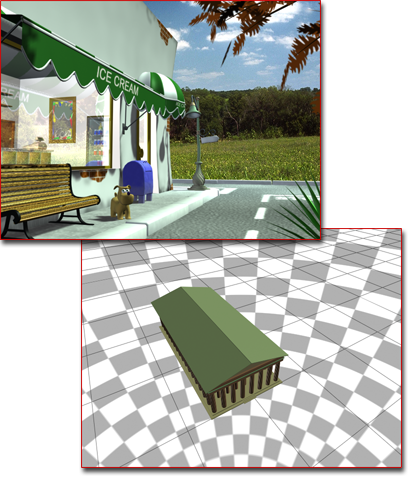You can use a map for the background of a scene. Reflection maps and Refraction maps also use environment coordinates instead of texture coordinates.

Click the Material Editor icon on the Main toolbar or press M. Click and hold the icon to show the flyout.
While texture coordinates project a map onto particular geometry, environment coordinates project a map onto the world coordinate system. If you move the object, the map remains in place. If you move the point of view, the view of the map changes. This type of mapping system is used with reflection, refraction, and environment maps.

Above: Image uses a picture as a background. The environment map uses screen coordinates.
Below: Image shows a checkered map applied to the environment using spherical mapping coordinates.
There are four types of environment coordinates:
- Spherical
- Cylindrical
- Shrink-Wrap
- Screen
The first three are the same as those used by the UVW Map modifier. If you imagine a sphere, infinite in size, surrounding your scene and mapped with spherical mapping coordinates, you can visualize the effect you get with spherical environment mapping. Shrink-wrap wraps the map around a giant sphere, leaving only one singularity. Cylindrical is like a giant cylinder.
The Screen system maps the image directly to the view, with no distortion. It’s similar to planar projection, in that it's like a giant backdrop hung behind the scene. Unlike the other environment mapping methods, Screen is locked to the view. When you move the camera, the map moves with it. Therefore, you can use screen coordinates only for still renderings, or animations in which the camera doesn't move.
To use a bitmap with any environmental mapping system other than Screen, you need a high-resolution map because of the size of the virtual sphere or cylinder.
To assign an environment map as the background of the scene, use the Environment And Effects Dialog  Environment panel.
Environment panel.
Editing an Environment Map
To edit or adjust a map you assign by using the Environment And Effects dialog, you need to use the Material Editor. There are a few different ways to do so:
- In the
Compact Material editor:
- Activate an unused sample slot, click
 (Get Material), then in the
Material/Map Browser
(Get Material), then in the
Material/Map Browser  Scene Materials group, double-click the entry for the environment map.
Scene Materials group, double-click the entry for the environment map.
The map now appears in the sample slot, and you can use the rollouts below to edit its settings.
- Drag the map button on the Environment dialog, and drop it on an unused sample slot. When 3ds Max prompts you, be sure to specify Instance; otherwise, changes you make in the Material Editor won’t affect the environment map.
- Activate an unused sample slot, click
- In the
Slate Material editor:
- Drag the environment map from the Material/Map Browser panel
 Scene Materials group into the active View. When
3ds Max prompts you, be sure to specify Instance; otherwise, changes you make to the map settings wont affect the environment map. Double-click the map node so you can see the map settings, and adjust them, in the Parameter Editor panel.
Scene Materials group into the active View. When
3ds Max prompts you, be sure to specify Instance; otherwise, changes you make to the map settings wont affect the environment map. Double-click the map node so you can see the map settings, and adjust them, in the Parameter Editor panel.
- Drag the map button on the Environment dialog, and drop it on the active View. When 3ds Max prompts you, be sure to specify Instance; otherwise, changes you make to the map settings won’t affect the environment map. Double-click the map node so you can see the map settings, and adjust them, in the Parameter Editor panel.
- Drag the environment map from the Material/Map Browser panel
 Preferences
Preferences  Rendering, and then turn on Use Environment Alpha in the Background Antialiasing group. If Use Environment Alpha is turned off (the default) the background receives an alpha of 0 (completely transparent). If Use Environment Alpha is turned on, the alpha of the resulting image is a combination of the scene and background image's alpha. Also, when writing
TGA files with Pre-Multiplied Alpha set to off, turning on Use Environment Alpha prevents incorrect results. Only background images with alpha channels or black backgrounds are supported when compositing in other programs such as Photoshop.
Rendering, and then turn on Use Environment Alpha in the Background Antialiasing group. If Use Environment Alpha is turned off (the default) the background receives an alpha of 0 (completely transparent). If Use Environment Alpha is turned on, the alpha of the resulting image is a combination of the scene and background image's alpha. Also, when writing
TGA files with Pre-Multiplied Alpha set to off, turning on Use Environment Alpha prevents incorrect results. Only background images with alpha channels or black backgrounds are supported when compositing in other programs such as Photoshop.